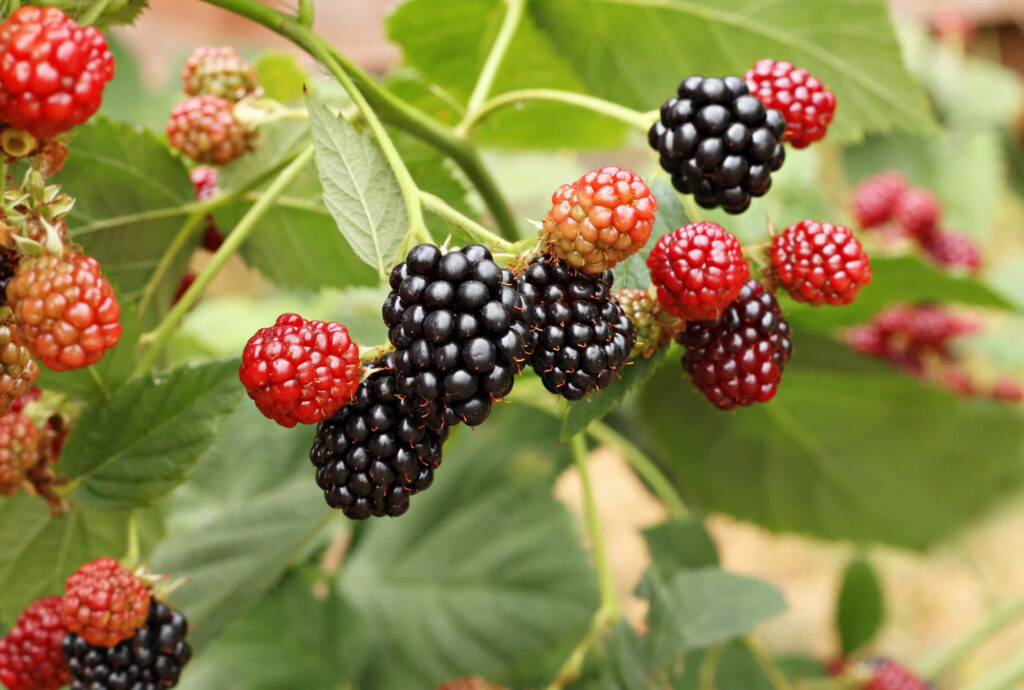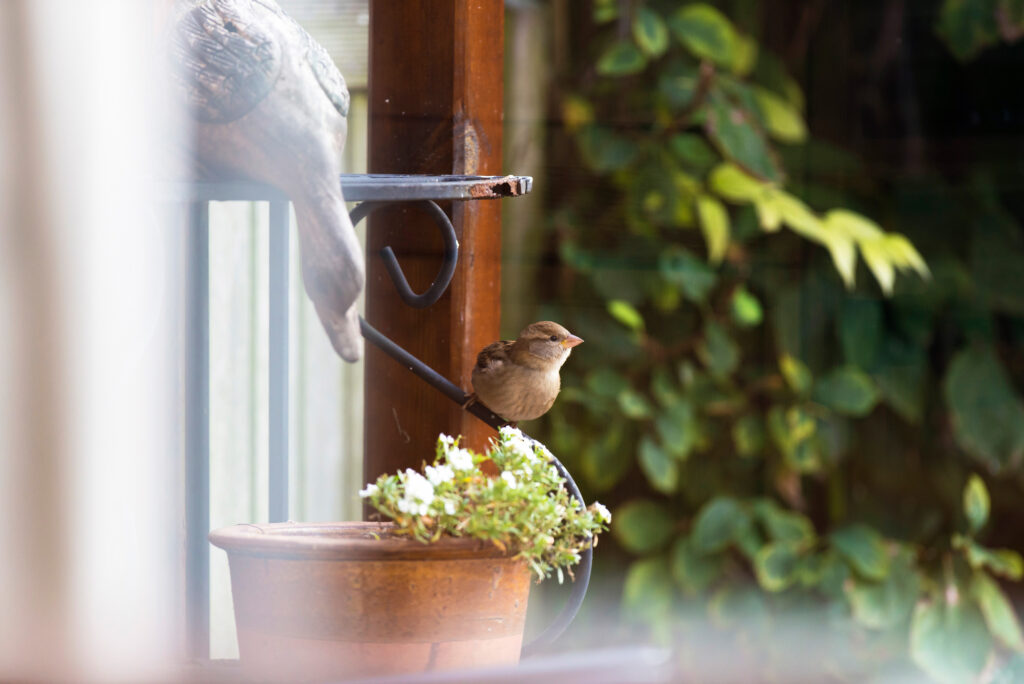People always talk about creating a garden that’s pollinator-friendly, you know, something suited for the bees and butterflies that’s full of colorful flowers.
But what about birds?
I get it, it’s easy to associate flowers and gardens with insects. But in reality, birds like flowers, too! And not only are they excellent pollinators as well, they are really entertaining to watch!
What’s more, is they also are attracted to a wide variety of other plants! This allows you to create a really intricate garden of trees, flowers, shrubs, and other greenery for your feathered friends.
Get ready to learn all you need to know about building a bird-friendly garden that is inviting to several species!
The Bird Garden Basics
Just like everything else in the world, birds need the basics—food, shelter, water. These things make them feel safe and will make your garden seem desirable.
Food
Bird diets are pretty variable depending on the species. There’s insectivores, herbivores, granivores, and nectivores, to name a few. Many species rely on several types of food. This means that you’ll have to have a variety of food sources if you want to attract all the birdies. This can be done primarily with the plants you choose to put in your landscape with feeders as a supplement.
Native plants
Plants that are native to the area will always be the best fit for your garden. Exotics can have pretty flowers, but those aren’t what your birds have a natural association with. Birds have relationships with plants because they provide certain nectars, seeds, or insects that they naturally eat, which ensures they’re getting proper nutrition. By planting natives that your birds know and love, you’ll have a greater chance of them spending more time in your garden.
1. Nectar
There’s dozens of bird species that consume nectar in North America. These include hummingbirds and orioles primarily, but also grosbeaks, mockingbirds, tanagers, and quite a few warblers. This makes flowers an important component in your garden!
When deciding what flowers would be best, it’s recommended to keep a few things in mind:
- Red, pink, and orange are the best colors for birds, whereas blues are preferred by bees.
- Tube-shaped flowers are suitable for long, slender bills, but not all nectivores have long, slender bills.
- Flowers that have staggered blooms provide food for longer throughout the season.
- Planting 3 or more plants of the same species is a rule of thumb, that way if a bird really favors a specific flower, they have several plants to feed on.
- Hummingbird feeders can be used by other birds, too, but should only be a supplement to your flowers.
Here’s a list of some native flower options (including blooms found on trees, shrubs and vines). I also recommend searching for a list of blooms native to your particular location!

Flowers
- Bearded tongue
- Bee balm
- Butterfly weed
- Cardinal flower
- Coral bells
- Fire Pink
- Hyssops
- Indian pink
- Jewelweeds
- Paintbrushes
- Phlox
- Red Columbine
- Salvias
- Solomon’s-seal
- Standing Cypress
Trees
- Madrone
- Red buckeye
Shrubs
- Coral bean
- Fairy duster
- Manzanitas
Vines
- Trumpet honeysuckle
- Trumpet vine
- Twinberry
2. Seed
Seed-bearing flowers and trees are just as important as those with nectar. Many granivorous species such as buntings, finches, sparrows, cardinals and doves will visit your garden even without a feeder present if they have access to these plants:

Flowers
- Allium
- Aster
- Black-eyed Susan
- Blanket flowers
- Coneflowers
- Coreopsis
- Cornflowers
- Cosmos
- Daisies
- Evening primroses
- Goldenrods
- Hibiscus
- Liatris
- Marigolds
- Moss roses
- Poppies
- Sunflower
Trees
- American Arborvitae
- Blue Spruce
- Birches
- Hemlocks
- Oaks
- Pines
3. Berries and Fruits
Shrubs and trees provide fruits and berries for birds, but also are sources of shelter! Mockingbirds, waxwings, tanagers, orioles, warblers, and bluebirds.

Shrubs
- Beautyberry
- Blackberry
- Chokeberry
- Elderberry
- Hollies (the berries are palatable by birds, but not by humans or pets!)
- Raspberry
- Serviceberry
- Spicebush
- Sumac
- Viburnum
- Virginia Rose
Trees
- American Bittersweet
- Black Cherry
- Juniper
- Red Mulberry
- Silky Dogwood
4. Insects
Any of these plants can attract insects, which will be eaten by chickadees, nuthatches, woodpeckers, wrens, bluebirds, tanagers.
Earlier we stressed that native plants are a must in your garden, and this is one example why. Native plants attract native bugs that are vital to birds. If the bugs aren’t around to eat because your landscape is filled with nonnative plants, your birds suffer greatly!
As mentioned earlier, you can use feeders with high quality feed to supplement your plants. These can be nectar or seed feeders. Even with feeders, birds will usually get most of their food from natural sources on their own. This makes it EXTRA important to have a variety of sources available that provide ALL food types!
Water

Another basic necessity in your garden is water. Water helps birds digest their food and helps them cool off and get clean. Plus, it can pull together the look of your garden. Include several watering options in your garden.
You can get really creative here. There are so many designs of baths and watering options, so you’ll have a lot of room when buying something to match your garden’s personality.
1. Bird Baths
Bird baths are a lot of fun to watch! Seeing the birds gather around and flutter in the bath and watching them get all goofy looking when soaked with water—it’s adorable!
A few bird bath tips:
- Keep the water depth to 3 inches or less.
- If the surface of the bath is super smooth and slippery, add some rocks for grip.
- Make sure to keep your baths clean by washing them weekly and replacing the water daily if it’s gross. You don’t want it to be dirty or a breeding ground for mosquitoes.
Types of bird baths:
- There are pedestal bird baths, which might be what you typically think of when hearing “birdbath”. These are the saucer or bowl type baths that are elevated on a stand. These are perfect for the majority of birds who will visit your garden.
- Ground bird baths are another option and are really nice for those birds that like to spend time on the ground, like robins, doves, and sparrows.
- A fountain bird bath is really enticing to feathery visitors. It resembles a pedestal bath, but has a spray, drip, or bubble feature in the middle. You can find them as a single basin or with several tiers. The noise of the water will catch the birds’ attention and encourage them to come visit. These can be solar powered.
- Heated bird baths are perfect for winter. These baths have a thermostat and prevent the water from freezing. Keep in mind, this isn’t going to be a hot tub, but it could potentially save many birds from perishing. In winter, birds will eat snow to stay hydrated, but if there’s no snow around, yet the temperatures are too cold for flowing water, they will have a hard time staying hydrated. These can be solar powered.
2. Ponds
Ponds will be used the same way as bird baths and depending on the size, may attract more than just songbirds. Non-avian wildlife and larger birds may stop by to use the pond. If you plan on building one, make sure to include shelves and plants to help it flow and stay clean. Also pay attention to potential issues, such as runoff into your pond from neighbors.
3. Misters
Some birds don’t have time in their day to take a luxurious bath (hummingbirds!) so they prefer to fly through mists and sprays of water instead. Point the mister at some of your foliage to get them glistening. Birds will come down and rub on the wet leaves for a quick rinse.
Shelter
The last component of a great bird garden is shelter. This includes daily shelter, but also shelter for nesting.
When designing your garden to have suitable shelter options remember: the more, the merrier.
You’re going to want lots of vegetation to minimize the open space as much as possible. There’s no shelter in open space, and no safety.
Lots of layers of different kinds of plants, shrubs, and trees is ideal. You need plants at every level to suit the needs of many birds. Some are ground dwellers, some like shrubs, and some prefer treetops. This is for their daily living as well as nest building. And guess what, it doesn’t need to be orderly and tidy. Let it be chaotic and busy! Just take up as much space as possible and let it be a little bird paradise.
To encourage your birds to stick around, you can put up some bird houses suited for specific species, but don’t go overboard with them! Birds will tolerate eating together, but like to have their space when raising babies.
Key takeaways when designing your bird garden:
- Native plants are best
- Provide all food types
- Diversity
- Vegetation should have layers
- Lots of water
- Fill the empty spaces
This guide will bring you one step closer to the bird garden of your dreams. Reach out to your local landscapers and nurseries for specific ideas, recommendations, and help if you need it!
ALSO, if you meet the requirements of food, water, shelter, and places to raise babies, you can certify your yard as a Certified Wildlife Habitat through the National Wildlife Federation, which is pretty cool! You’ll even get a certificate and the option to buy a neat plaque to post up in front of your garden. Excuse me, wildlife habitat. Yeah, that sounds awesome!
Anyways, happy birding!!
Credits
Greenwich Audubon Center. (2020, January 28). Native Shrubs for Birds. Retrieved 2020, from https://greenwich.audubon.org/learn-and-explore/native-shrubs-birds
Mayntz, M. (2018, October 25). Design a Bird-Friendly Landscape With These Tips. Retrieved 2020, from https://www.thespruce.com/design-a-bird-friendly-landscape-386418
Mayntz, M. (2019, June 11). Attract Birds With Seed-Bearing Flowers. Retrieved 2020, from https://www.thespruce.com/seed-bearing-flowers-for-birds-386405
Mayntz, M. (2020, January 18). Types of Bird Baths and Which Ones Are Best. Retrieved 2020, from https://www.thespruce.com/types-of-birdbaths-386982
National Audubon Society. (2016, April 13). The Audubon Guide to Attracting Hummingbirds and Orioles. Retrieved August, 2020, from https://www.audubon.org/news/the-audubon-guide-attracting-hummingbirds-and-orioles
Rennicke, C. (2020, April 24). Plants that Attract Birds in All Seasons. Retrieved 2020, from https://www.birdsandblooms.com/birding/attracting-birds/plants-and-trees-that-attract-birds/plants-attract-birds-seasons/
Slavin, Z. (2017, February 10). Grow These Native Plants So Your Backyard Birds Can Feast. Retrieved 2020, from https://www.audubon.org/news/grow-these-native-plants-so-your-backyard-birds-can-feast
Youth, H. (2018, November 27). Attract Birds: A Dozen Native Trees and Shrubs that Birds Love. Retrieved 2020, from https://abcbirds.org/blog/native-trees-shrubs-attract-birds

